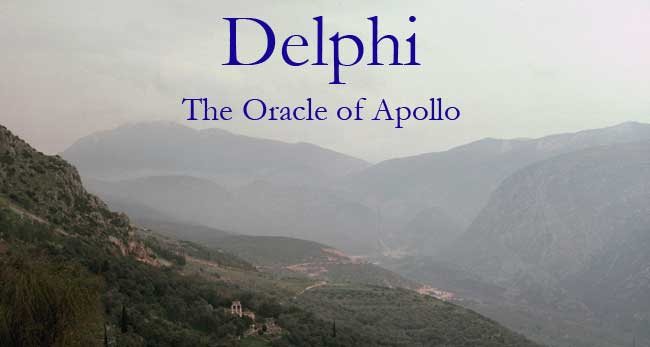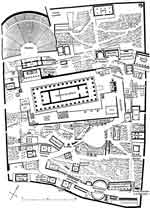
The Temple of Apollo
 The Sacred way leads up to the Great Altar in front of the Temple of Apollo, which, owing to the slope of the ground, stands on an artificial platform held in place by a retaining wall of polygonal stones (right).
The Sacred way leads up to the Great Altar in front of the Temple of Apollo, which, owing to the slope of the ground, stands on an artificial platform held in place by a retaining wall of polygonal stones (right).
According to tradition as recounted by Pausanias, the original temple was made out of laurel leaves gathered in the Vale of Tempe in northern Greece; the second was made of beeswax and feathers sent by Apollo from the land of the Hyperboreans; and the third was made out of bronze. The earliest temple to have left any archeological traces dates to the latter part of the 7th century BC and was alleged to have been built by the legendary architects, Trophonios and Agamedes. It was destroyed by fire in 548 BC (the cause of the fire is unknown) and some of it was incorporated into the fill of the terrace.
 It was replaced by the so-called ‘Alcmaeonid ’ temple. The Alcmaeonids were a prominent Athenian family who had been exiled from the city for political reasons. Funds were raised throughout the Greek world and beyond. Croesus of Lydia and Amasis of Egypt contributed substantially to the 300 talents required for the job. The Alcmaeonids were contracted to oversee the work, which seems to have been completed by 505 BC. The new temple (reconstructed left) was a Doric hexastyle building with six columns at each end and fifteen along the sides. The sculpture of the pediment was carved by the Athenian artist, Antenor, some fragments of which are now on display in the museum. The decoration of the western pediment was carved out of the local poros , an inferior type of limestone that was then coated with plaster. The main theme is the Gigantomachy but little of it has survived. On the eastern façade, however, the Alcmaeonids paid the extra to bring in the finest marble from the island of Paros. It shows Apollo arriving by chariot at Delphi.
It was replaced by the so-called ‘Alcmaeonid ’ temple. The Alcmaeonids were a prominent Athenian family who had been exiled from the city for political reasons. Funds were raised throughout the Greek world and beyond. Croesus of Lydia and Amasis of Egypt contributed substantially to the 300 talents required for the job. The Alcmaeonids were contracted to oversee the work, which seems to have been completed by 505 BC. The new temple (reconstructed left) was a Doric hexastyle building with six columns at each end and fifteen along the sides. The sculpture of the pediment was carved by the Athenian artist, Antenor, some fragments of which are now on display in the museum. The decoration of the western pediment was carved out of the local poros , an inferior type of limestone that was then coated with plaster. The main theme is the Gigantomachy but little of it has survived. On the eastern façade, however, the Alcmaeonids paid the extra to bring in the finest marble from the island of Paros. It shows Apollo arriving by chariot at Delphi.

The Remains of the Apollo Temple
This temple was destroyed by a great earthquake in 373 BC and was replaced by the building whose remains can be seen today. The design was essentially the same as its predecessor and retained the ratio of 6 x 15 columns. The work has been attributed to the Corinthian architects Spintharos, Xenodoros, and Agathon while the pedimental sculptures are said to be the work of Praxias and Androsthenes of Athens. Unfortunately, not so much as a fragment of their work has been found—perhaps they were carted off to Rome by Nero in the first century AD. The entablature was decorated with shields captured from the Persians at Plataea. According to tradition, the maxims, “know thyself,” “nothing in excess” and “make a pledge and mischief is nigh” were carved into the walls, along with the letter E. This temple was badly damaged during the Thracian raids of 88 BC and restored by Domitian nearly 200 years later. After the  excavations by the French the foundations of the outer colonnade and the cella were econstructed along with some of the columns.
excavations by the French the foundations of the outer colonnade and the cella were econstructed along with some of the columns.
When they dug into the interior, the French found a number of features that were unusual for a temple of the period. In the first place, the adyton, the holy-of-holies, was sunk some 2-4 metres below the level of the surrounding floor. They also noted the presence of an elaborated drainage system built int the adjacent foundations and designed to carry away spring water. Nearby the excavators found a block of limestone (left) about 35 cm. thick, 1.35 metres long and nearly 1 metre across that almost certainly had been part of the floor. It was pierced by a hole about 10 cm. across at the top and 18 cm. at the bottom. There was also a triangular setting of sockets enclosed by a shallow channel which led past the hole. The channel had deposits of travertine (aform of limestone laid down by mineral springs).
One interpretation immediately springs to mind. The sockets was the setting of the tripod where the priestess sat, the trough carried away the waters of the Kassotis spring, and the funnel-shaped hole conducted the sacred vapours from beneath the adyton. If the original omphalos was hollow perhaps it stood on top of the opening and channelled the pneuma through an aperture at the top and into the nostrils of the oracle. Leicester B. Holland, an American architect, suggested that there was a secret chamber where cannabis was burned during the oracular sessions, accounting for the sweet aroma noted by visitors. However, no trace of such a chamber has been found.

Plan of the Apollo Temple
Geological Studies
In the 1980s, a geological study of Greece was undertaken by the United Nations Development Project examining active fault lines and assessing their potential impact on nuclear power plants. One of the scientists taking part was Jelle Zeilinga de Boer of Wesleyan University who noted the appearance of a fault line on the southern slope of Mount Parnassus to the east and west of the sanctuary and apparently running right through it. It is strange that this escaped the notice of archaeologists and classicists, especially given the frequent references to them in the ancient texts. Faults such as the one noted by de Boer are cracks in the earth’s crust caused by the movement of tectonic plates. Since the fracture is rarely clean there are almost inevitably minor cracks and clefts associated with them. If these go deep enough, they are quite capable of conducting gases to the surface.
De Boer, unaware of the controversy surrounding the oracle, let the matter rest but a chance encounter with an archaeologist, John R. Hale, from the University of Louisville changed all that. In 1996, they traced the east-west fault line, the Delphi Fault, and discovered a second running northwest-southeast which they dubbed the Kerna Fault. It was traced by a line of springs, including the Kassotis, that ran through the site above and below the temple, where the the two lines intersected. In addition, travertine deposits found on the slopes above the temple suggested that the spring water had risen through layers of limestone that lay deep beneath the earth’s surface. In fact, an earlier geological study of the area, carried out by the Greek government, showed that layers of bituminous limestone, with a petrochemical content of up to 20%, underlay the valley. If layers were heated, say by the friction created by shifting plates, the petrochemicals may well have vaporized and risen to the surface along with the water, particularly at places where fault lines intersected.
Support for this line of reasoning was supported by discoveries made by the French archaeologist shortly after Oppé’s article appeared in 1904. Underneath a layer of brown clay they found rock that had been “fissured by the action of the waters.” However, it is equally possible that these cracks may have been caused by tectonic movements and subsequently widened by groundwater. Faults such as these in areas of bituminous limestone in other parts of the world are known to produce hydrocarbon gases such as methane and ethane, both of which were found in travertine samples collected at Delphi. Traces of both were found in water samples collected from various springs in the vicinity. In addition, water from the Kerna spring inside the sanctuary showed traces of ethylene, a sweet smelling gas consistent with Plutarch’s description.
Experiments carried out by the American anaesthesiologist Isabella Herb in the 1920s showed that, while large doses of ethylene (over 20%) can cause the subject to pass out, lower amounts lead to a state of trance with the subject remaining awake and responsive to questioning. Although their speech patterns and intonation might change, their answers are clear and logical. They might also experience out-of-body feelings and euphoria but the symptoms disappeared once the subject stopped inhaling the gas. Occasionally, more violent reactions occurred and the subject began to rave incoherently and thrash about, often losing their balance and falling over repeatedly. Again, according to Plutarch who was a priest at the temple and witness to numerous prophecies, all of these symptoms match those he observed of the Pythia in action.
Directly in front of the temple stood the Altar of the Chians (far right), which was erected by the islanders in the fifth century BC and gave them the right to move to the head of the queue when it came to posing questions to the oracle. The monument measures 8.6 x 5.1 metres and was made out of black marble except for the base and the cornice, which were white. It was restored in the 1920s. To the right of the temple as you face it, is the base for a colossal statue of the god, Apollo Sitalkas (an epithet connected with the harvest). It was said to be 16 metres high and paid for by the Amphictiony out of the fine levelled on the Phocians at the end of the Third Sacred War.
Later Dedications
By the time the latest temple was built in the fourth century BC, space was at a premium along the Sacred Way and new monuments were built on the slopes above. At the same time, there was a tendency away from civic sponsorship to individual dedications. This became especially true among the Hellenistic kings who followed Alexander the Great.
The oldest monument to the north of the temple was the Lesche of the Cnidians, which stood on a raised platform against the back wall of the sacred enclosure. A lesche was a was a small columned hall, a place where men could gather and converse or simply relax. It was built around the middle of the fifth century and decorated with paintings by Polygnotus of Thasos depicting the Fall of Troy and the Descent of Odysseus to Hades. The building was lovingly maintained and was described in glowing terms by Pausanias some 700 years later.
At some point during the fourth century a tall (10.9 metres) column decorated with acanthus leaves was set up, possibly by the Athenians, just outside the entrance to the temple. At the top, supported by statues of three dancing women, was a bronze tripod and cauldron. The capital and figures can be seen in the Delphi Museum. Just behind the base of the column and slightly uphill are the remains of a monument built by Daochos II, who was appointed one of the four tetrarchs of Thessaly by Philip II of Macedon. It consisted of a setting of nine marble statues representing himself and some of his ancestors along with the god Apollo. Following the death of Alexander in 323 BC, Krateros, one of his chief generals and closest friends, erected a large porticoed niche

Pella. Mosaic of Alexander & Krateros hunting lions
containing a bronze sculpture group showing him saving the king’s life during a lion hunt. The statues disappeared a long time ago but the same scene is depicted in a contemporary mosaic from Pella in Macedonia and the setting must have been pretty similar. Later Hellenistic rulers, such as Eumenes II and Attalos I of the wealthy kingdom of Pergamum erected statues of themselves and the latter also dedicated a two-storeyed stoa that extends beyond the eastern boundary of the site. Much later, in the fourth century AD, it was converted into a cistern to supply the Roman baths with water.
The Roman impact on the site was decidedly negative. There are the foundations for a tall pedestal that was once topped by an equestrian statue of the Roman general, Aemilius Paulus, who defeated the Macedonians and ‘liberated’ Greece but overall the Romans took away far more than they added.






